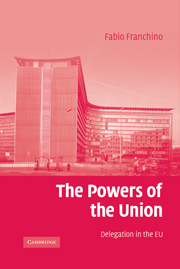Book contents
- Frontmatter
- Contents
- List of figures
- List of tables
- Preface
- 1 Introduction
- 2 A formal model of delegation in the European Union
- 3 Data and longitudinal analysis
- 4 Decision rules, preferences and policy complexity
- 5 Delegation in the European Union: quantitative analysis
- 6 Delegation in the European Union: case studies
- 7 The delegation preferences of the European Parliament
- 8 Conclusion
- References
- Index
7 - The delegation preferences of the European Parliament
Published online by Cambridge University Press: 27 October 2009
- Frontmatter
- Contents
- List of figures
- List of tables
- Preface
- 1 Introduction
- 2 A formal model of delegation in the European Union
- 3 Data and longitudinal analysis
- 4 Decision rules, preferences and policy complexity
- 5 Delegation in the European Union: quantitative analysis
- 6 Delegation in the European Union: case studies
- 7 The delegation preferences of the European Parliament
- 8 Conclusion
- References
- Index
Summary
The analysis of the previous two chapters is centered on the Council of Ministers and the Commission and the data set in Chapter 5 covered the period from the establishment of the then European Economic Community up to 1992. By serendipity, in November of the following year the Treaty of Maastricht came into force and a new major institution, the European Parliament (EP), entered the scene of EU legislative politics. Its powers were moderately expanded in July 1987 with the cooperation procedure of the Single European Act. However, it was the codecision procedure of the Maastricht Treaty, later amended by the Amsterdam Treaty, that granted this institution law-making powers on an equal footing with the Council. How is the involvement of the Parliament likely to affect the choices of implementation path (centralization) and the level of discretion (bureaucratization)? How and when do the Parliament's discretion preferences differ from those of the Council? Should we expect greater centralization and bureaucratization?
This chapter addresses these important questions. In the next sections, after reviewing the current literature on the Parliament, I introduce the expectations about the differences between the discretion preferences of the Parliament and the Council, which have been derived from Propositions 2.9–2.11 of the model in Chapter 2. After a detailed description of codecision, I then proceed to test these expectations through both a quantitative and a content analysis of the amendments to 414 codecision proposals adopted by the Parliament.
- Type
- Chapter
- Information
- The Powers of the UnionDelegation in the EU, pp. 238 - 291Publisher: Cambridge University PressPrint publication year: 2007

